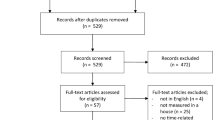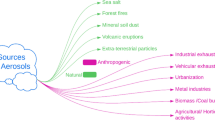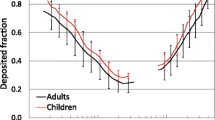Summary
From 270 published laboratory airborne death rate measurements, two regression models relating the death rate constant for 15 bacterial species to aerosol age in the dark, Gram reaction, temperature, and an evaporation factor which is a function of RH and temperature were obtained. The independent variables accounted for 94% of the variation in the data for each of the two models. In both models the regression shows an increased survival rate with aerosol age accounting for approximately 90% of the total variation in the data. The remainder of the total variation was explained by temperature and RH (in interaction with the Gram reaction) in one model and by the evaporation function (in interaction with the Gram reaction) in the order model. Death rate data for gaseous atmospheric contamination, and light experiments were too few for building a regression model. In addition, these points were not well fit by the model indicating further research is needed to prepare realistic prediction models for airborne bacterial survival.
Similar content being viewed by others
References
Cox C.S., (1987) —The aerobiological pathway of microorganisms. John Wiley and Sons, Inc., N.Y. 393 p.
Cox C.S., Goldberg L.J., (1972) —Aerosol survival of Pasteurella tularensisand the influence of relative humidity. Appl. Microbiol.23(1):1–3.
Dimmick R.L., Wolochow H., Chatigny M.A., (1979) —Evidence for more than one division of bacteria within airborne particles. Appl. Environ. Microbiol.38(4):642–643.
Ehrlich R., Miller S., (1973) —Survival of airborne Pasteurella tularensisat different atmospheric temperatures. Appl. Microbiol.25(3):369–372.
Ehrlich R., Miller S., Walker R.L., (1970) —Relationship between atmospheric temperature and survival of airborne bacteria. Appl. Microbiol.19(2):245–249.
Ferry R.M., Brown W.F., Damon E.B., (1958) —Studies on the loss of viability of stored bacteria aerosols. II. Death rates of several non-pathogenic organisms in relation to biological and structural characteristics. J. Hyg.56:125–150.
Goldberg L.J., Watkins H.M.S., Boerke E.E., Chatigny M.A., (1958)The use of a rotating drum for the study of aerosols over extended periods of time. Amer. J. Hyg.68:85–93.
Graham D.C., Quinn C.E., Sells I.A., Harrison M.D., (1979) —Survival of strains of Soft Rot Coliform bacteria on microthreads exposed in the laboratory and in the open air. J. Appl. Bacteriol.46:367–376.
Lighthart B., (1973) —Survival of airborne bacteria in a high urban concentration of carbon monoxide. Appl. Environ. Microbiol.25(1):86–91.
Lighthart B., Hiatt V.E., Rossano A.T. Jr., (1971) —The survival of airborne Serratia marscensensin urban concentration of sulfur dioxide. Air Pollut. Control Assoc.21(10):639–642.
Lighthart B., Kim J., (1989) —Simulation of airborne microbial droplet transport. Appl. Environ. Microbiol.55(9):2349–2355.
Neter J., Wasserman W., Kutner M.H., (1983) —Applied linear regression models. Richard D. Irwin, Inc., Homewood, IL.
Poon C.P.C., (1966) —Studies on the instantaneous death of airborne Escherichia coli. Amer. J. Epidemiol.84:1–9.
Poon C.P.C., (1968) —Viability of long-storaged airborne bacterial aerosols. J. Sanitary Engin. Div., Proc. Amer. Soc. Civil Engin. SA6:1137–1146.
Reist P.C., (1984) —Introduction to aerosol science. Macmillan Publ. Co. N.Y., p. 299.
Webb S.J., (1959) —Factors affecting the viability of airborne bacteria. I. Bacteria aerosolized from distilled water. Can. J. Microbiol.5:649–669.
Webb S.J., (1960) —Factors affecting the viability of airborne bacteria. III. The role of bonded water and protein structure in the death of air-borne cells. Can. J. Microbiol.6:89–105.
Webb S.J., (1961) —Factors affecting the viability of airborne bacteria. IV. The inactivation and reactivation airborne Serratia marscensensby ultraviolet and visible light. Can. J. Microbiol.7:607–619.
Webb S.J., (1961) —Factors affecting the viability of airborne bacteria. V. The effect of desiccation on some metabolic systems of Escherichia coli. Can.J.Microbiol.7:621–631.
Webb S.J., (1963) —The effect of relative humidity and light on air-dried organisms. J. Appl. Bacteriol.26(3):307–313.
Wright D.N., Bailey G.D., (1969) —Effect of relative humidity on the stability of Mycoplasma pneumoniaeexposed to simulated solar ultraviolet and to visible radiation. Can. J. Microbiol.15:1449–1452.
Wright D.N., Bailey G.D., Goldberg L., (1969) —Effect of temperature on survival of airborne Mycoplasma pneumoniae. J. Bacteriol.99(2):491–495.
Wright D.N., Bailey G.D., Hatch M.T., (1968) —Survival of airborne Mycoplasmaas affected by relative humidity. J. Bacteriol.95(1):251–252.
Author information
Authors and Affiliations
Rights and permissions
About this article
Cite this article
Lighthart, B. A statistical model of laboratory death rate measurements for airborne bacteria. Aerobiologia 5, 138–144 (1989). https://doi.org/10.1007/BF02486511
Issue Date:
DOI: https://doi.org/10.1007/BF02486511




